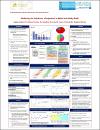Reducing the incidence of exposure to blood and body fluids
| المؤلف | Sallam, Naglaa |
| المؤلف | Hassan, Reham |
| المؤلف | Shurrab, Alaedine |
| المؤلف | Al Deeb, Yasser |
| المؤلف | Shraim, Mujahed |
| تاريخ الإتاحة | 2020-10-26T08:49:55Z |
| تاريخ النشر | 2020 |
| اسم المنشور | Qatar University Annual Research an Exhibition 2020 (quarfe) |
| الاقتباس | Sallam N., Hassan R., Shurrab A., AlDeeb Y., Shraim M., " Reducing the incidence of exposure to blood and body fluids", Qatar University Annual Research Forum and Exhibition (QUARFE 2020), Doha, 2020, https://doi.org/10.29117/quarfe.2020.0184 |
| الملخص | Methods: we used a Pareto chart to identify priority areas for our project based on magnitude of incidence of BBF exposures. A driver diagram was developed with four main primary drivers including risk awareness, attitudes and practice, staff experience, and leadership engagement. Interventions ramps and changes were implemented using multiple PDSA cycles addressing staff knowledge and awareness about BBF exposure prevention and management using surveys and learning brochures and assessment of staff compliance with safe practice. The project included the following measures (i) outcome measure: number of days between BBF exposure incidents; (ii) Process measures: BBF exposure risk awareness score, attitude and practice score, and proportion of staff compliant with BBF exposure safe practice; (iii) BBF reporting exposure score and proportion of staff satisfied with BBF exposure prevention and management policy. Ethical approval of the project was not required. Results: about 80% of BBF exposure incidents were due to needlestick injuries. Emergency unit, operating theatre, hemodialysis unit, laboratory unit, and utility services accounted for 80% of all BBF exposure incidents. Around 47% of the incidents occurred among nurses. Our project was associated with increase in attitude and safe practice score form 75% to 100%. The compliance with safe practice increased from 77% to 86%, and reporting of exposure increased from 75% to 100%. Staff satisfaction increased from 65% at baseline to 96%. Knowledge about prevention and management of BBF exposure (safe practice) increased from 60% to 92% in the hemodialysis unit. However, the median number of days between BBF exposures increased from 13 days at baseline to 18 days in May 2019. Conclusion: our quality improvement project has identified the priorities clinical areas accounting for the majority of BBF exposure incident. The initial phase of the project in hemodialysis unit was associated with significant increase in knowledge scores about prevention and management of BBF exposure, compliance with safe practice, and staff satisfaction. In addition, the project was associated with significant increase in reporting of BBF exposure, which explains why we were not able to increase the median number of days between BBF exposures to 50 days. We have started spreading our interventions and change ideas to other units in Al-Khor general Hospital. Quality improvement projects can reduce the incidence of BBF exposure having the priority areas identified and the relevant drivers are addressed appropriately |
| اللغة | en |
| الناشر | Qatar University Press |
| الموضوع | Quality Improvement Blood and body fluid Exposure Risk Prevention |
| النوع | Poster |
الملفات في هذه التسجيلة
هذه التسجيلة تظهر في المجموعات التالية
-
Theme 2: Population, Health & Wellness [118 items ]


